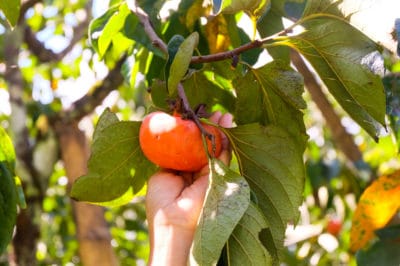Astringency
One bite of unripe fruit from the wild American persimmon tree (Diospyros virginiana) or the Oriental persimmon (Diospyros kaki) ‘Hachiya,’ and you’ll feel like your mouth has turned to cotton. Why?
Because of astringency. Some unripe persimmons are loaded with tannins – the same compounds used to tan leather. Tannins instantly bind with proteins in your saliva, stopping its production and leaving you with a seriously parched and puckered mouth.
Many plants, including persimmons, produce tannins as a defense mechanism. For many animals, a diet containing just 5 percent tannins is lethal. In other words, most wildlife won’t eat astringent persimmons until they’ve ripened and lost their tannins. This gives the tree’s seeds a chance to mature and then germinate when the animals disperse them.
Non-astringent persimmons also contain tannins, but in amounts only 1/40th to 1/5th of those in astringent ones.
Other astringent persimmon cultivars include:
- ‘Eureka’
- ‘Honan Red’
- ‘Saijo’
- ‘Tamipan’
- ‘Maru’
Non-astringent cultivars include:
- ‘Fuyu’
- ‘Imoto’
- ‘Jiro’
- ‘Gosho’
- ‘Siruga’
Expert gardener’s tip: Only Oriental persimmons are commercially cultivated and of them, ‘Hachiya’ and ‘Fuyu’ dominate the market.
Picking Wild Persimmons
Allow wild persimmons to ripen on the tree. Those on the same tree ripen at different rates, so picking season may run from mid-September until February. It depends on your USDA hardiness zone; the trees grow in zones 4 through 9.
Ripe wild persimmons are bright orange, squishy-soft and about 1 1/2 inches around. They drop from the branches and often simply splatter on the ground. For an intact harvest, spread tarps beneath a tree and shake the branches very gently.
Picking Astringent Oriental Persimmons
Pick astringent Oriental persimmons (USDA zones 7 through 11) when they’re still hard and at the peak of color (‘Hachiya’ fruit is tomato red). For most varieties, harvest season occurs sometime between mid-September and late November. Ripen them at room temperature in a protected spot until they’re jelly soft.
Expert gardener’s tip: Another option is to put astringent persimmons and ethylene gas-releasing bananas in a sealed plastic bag. They’ll ripen in two to four days.
Picking Non-Astringent Persimmons
When their color peaks, non-astringent persimmons are ready to pick and eat. At this stage, their texture is apple-crisp and firm. The most commonly grown varieties, including pumpkin-orange ‘Fuyu’ and red-orange ‘Jiro,’ ripen between mid-October and mid-November.
